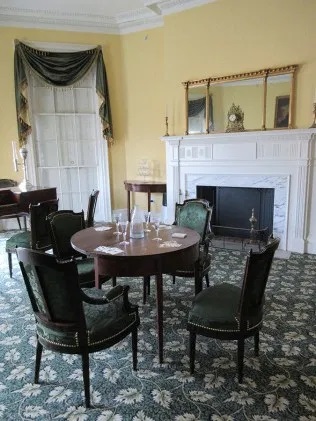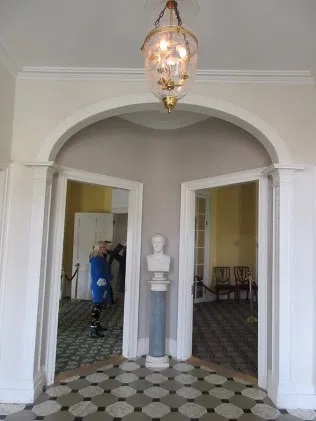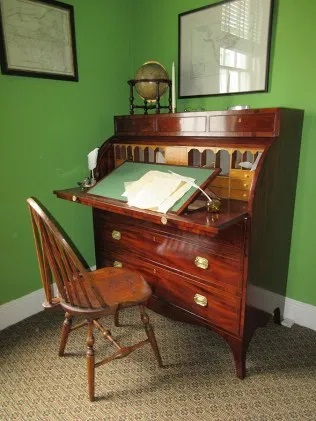A Tour of Hamilton Grange
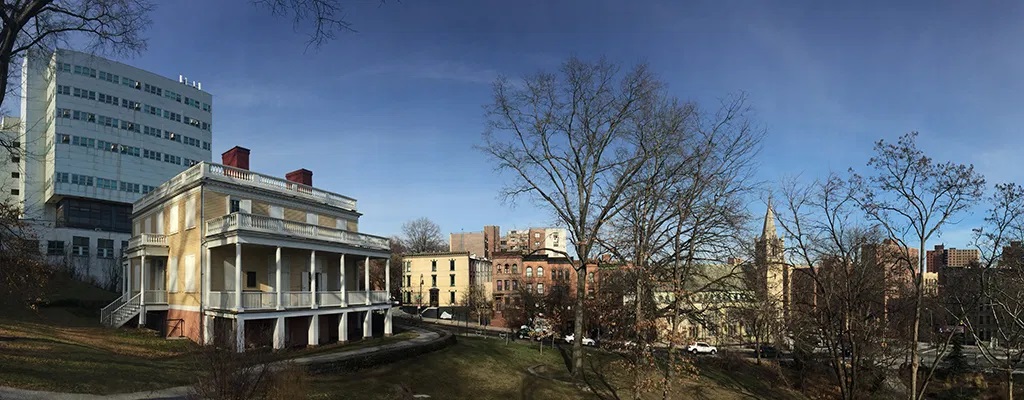 As mentioned in the writeup of the NY V.I.P. Weekend, the Trust’s visit to Hamilton Grange was cancelled due to the weather. Matt and Christian did visit the site a few days prior to reconnoiter, however, and found it an engaging and interesting museum. Long a hidden and little-visited National Memorial under the National Park Service’s care, the house has undergone a resurgence in recognition and visitor numbers. The first boost followed a move to a new location; the second because of the incredible popularity of the runaway hit musical Hamilton—a fun intersection of the decorative arts and pop culture!
As mentioned in the writeup of the NY V.I.P. Weekend, the Trust’s visit to Hamilton Grange was cancelled due to the weather. Matt and Christian did visit the site a few days prior to reconnoiter, however, and found it an engaging and interesting museum. Long a hidden and little-visited National Memorial under the National Park Service’s care, the house has undergone a resurgence in recognition and visitor numbers. The first boost followed a move to a new location; the second because of the incredible popularity of the runaway hit musical Hamilton—a fun intersection of the decorative arts and pop culture!
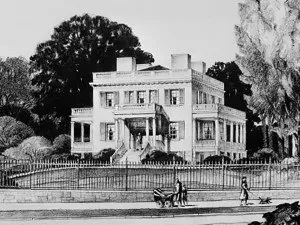
A view of Hamilton Grange in it’s original location, image courtesy of the Library of Congress.
Alexander Hamilton, the fiery founding father and first Treasury Secretary, built the house between 1801 and 1802 on thirty-two acres in the rural northern neck of Manhattan Island. In that era, it was about nine miles from the center of New York City. It was the only home Hamilton ever owned outright, and he worked with architect John McComb Jr., who would later design New York’s City Hall, to create an appropriate country house in the Federal style. The original structure, with front and rear porticos and side piazzas extending the length of the house, faced south on the high point of the property, and overlooked Manhattan and even across the Hudson into New Jersey on a clear day.
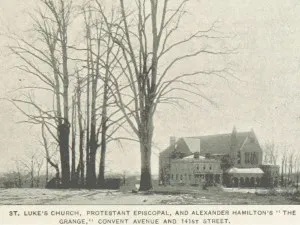
A view of the second location of Hamilton Grange after it’s move next to St. Luke’s Church. Image courtesy of the British Library
Sadly, Hamilton’s occupation of the house ended prematurely with his death in 1804 following the ill-fated duel with Aaron Burr. His widow Elizabeth continued to use the house as a summer home until selling it in 1833. By 1889, the grid established by Commissioner’s Plan of 1811 had reached Harlem Heights, and the house stood in the way. The developer who had purchased the property gave the structure to St. Luke’s Episcopal Church, and the house moved to the newly laid Convent Avenue on a series of horse-drawn carts. Reoriented and heavily reconfigured inside and out, Hamilton Grange served as a substitute chapel until the church’s completion. In 1924, the church sold the building to the American Scenic and Historic Preservation Society to operate as a house museum.
At this point the interpretation and furnishing of Hamilton Grange began to encounter some serious difficulties. Although early floorplans survive, the probate inventory for Hamilton’s estate does not. Furniture and household articles with a Hamilton family provenance may—or may not—have been used at the house during his lifetime. The changes to the house’s interior arrangements also made its interpretation difficult, on top of the fact that it’s location on Convent Avenue—tucked between St. Luke’s and an apartment building—essentially removed it from the public eye.
By 2008, the house had become both a National Historic Landmark and a National Memorial. To better preserve and interpret the site, and hopefully increase public interest and visitor attention, National Park Service officials decided to move the house, for the second time, a few hundred feet away to a new location in St. Nicholas Park, next to the campus of the City College of New York. The open park approximated the house’s original setting, and allowed for the rebuilding of the porticos and side piazzas.
The second move for Hamilton Grange was more technically complicated then the horse-and-cart affair of 119 years earlier. The house was raised ten feet, slid over the projecting portico of the church, lowered onto an extensive system of truck beds, and pulled downhill and around the corner to its new location. Despite the complexities involved, the move took only one day and turned into a celebratory community event. The move made national news, and a movie of how it was accomplished, which can be viewed here, was produced by Wolfe House & Building Movers, the firm that moved the house.
After the relocation and subsequent restoration of the floorplan to its original configuration complete, the National Park Service faced the challenge of furnishing the house in an authentic and historically sensitive manner. In some cases, the process was easy. Paint analysis determined the original wall and molding colors, which were reproduced and complemented by period-appropriate carpets and elegant window treatments. The movable goods that inhabited the spaces, however, proved more difficult to track down. Because there is no surviving probate inventory, and the records of Hamilton’s household purchases are thin, the NPS turned to a combination of connoisseurship, conservation, and educated guesses about the house’s contents.
Some furniture with Hamilton provenance does survive, but could well have come from any of the townhouses he rented in New York City or Philadelphia. The suite of parlor furniture is attributed to Philadelphia cabinetmaker Adam Hains and French emigre upholsterer George Bertault and likely would have been purchased while serving as Secretary of the Treasury. For a devoted Anglophile, the acquisition of seating furniture in the French neoclassical taste was a curious decision. The unusual dining room chairs, with their inlaid, flat-top shield backs, may have come from upstate New York, where Hamilton’s wife Elizabeth was born, and may well have been used at Hamilton Grange in his lifetime. While the original pieces were undergoing conservation, the NPS decided to reproduce selected items to fill out the suites of parlor and dining room furniture, as well as reproduce some key pieces, such as Hamilton’s lap desk, in the Smithsonian’s collection, to aid the interpretation of his office. Today, these are displayed alongside the original furnishings, including a parlor settee and piano, to represent family life at Hamilton Grange as closely as possible.
We wish we could have brought our V.I.P. participants to visit in person. Thanks to the years of hard work and research by the National Park Service staff, and the assistance of a talented team of craftsmen for the conservation and reproduction work, the house is now a gem of a museum, worthy of the fascinating and consequential figure who built it. We highly recommend a visit!
About The Decorative Arts Trust Bulletin
Formerly known as the "blog,” the Bulletin features new research and scholarship, travelogues, book reviews, and museum and gallery exhibitions. The Bulletin complements The Magazine of the Decorative Arts Trust, our biannual members publication.








